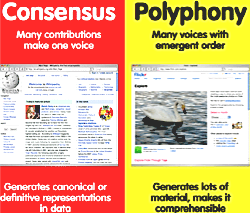What's That Noise?! [Ian Kallen's Weblog]
 Monday September 25, 2006
Monday September 25, 2006
Greater than the sum of its parts The other week I reflected on the scaling-web-2.0 theme of the The Future of Web Apps workshop. Another major theme there was how social software is different, how transformative architectures of participation are. There was one talk that stood out from Tom Coates, Greater than the sum of its parts. A few days ago the slides were posted; I poked through 'em since and they jogged some memories loose, I thought I'd share Tom's message, late though it is, and embellish with my spin.
 Tom's basic thesis is that social software enables us to do "more together than we could apart" by "enhancing our social and collaborative abilities through structured mediation." Thinking about that, isn't web 1.0 about structured mediation? Centralized services, editors & producers, editorial staff & workflow, bean counting eyeballs, customer relationship management, demographic surveys and all of that crap? Yes, but what's different is that web 2.0 structured mediation is about bare sufficiency in that it's better to have too little than too much, the software should get out of the way of the user, make him/her a participant, not lead him/her around by the nose.
Tom's basic thesis is that social software enables us to do "more together than we could apart" by "enhancing our social and collaborative abilities through structured mediation." Thinking about that, isn't web 1.0 about structured mediation? Centralized services, editors & producers, editorial staff & workflow, bean counting eyeballs, customer relationship management, demographic surveys and all of that crap? Yes, but what's different is that web 2.0 structured mediation is about bare sufficiency in that it's better to have too little than too much, the software should get out of the way of the user, make him/her a participant, not lead him/her around by the nose.
Next, Tom highlighted that valuable social software should serve
- Individual Motives
- An individual should get value from their contribution
- Social Value
- The individual's contributions should provide value to their peers as well
- Business/Organizational Value
- The organization that hosts the service should enable the user to create and share value and then derive aggregate value to expose this back to it users. I thought that was really well considered.
- anticipate reciprocity
- by offering value, it's reasonable to expect others to contribute value as well
- reputation
- by showing off a little, highlighting something uniquely yours to contribute, you gain prestige
- sense of efficacy
- by being able to make an impact, a sense of worth is felt
- identification with a group
- be it for altruism or attachment, contributing to a group makes you part of it
Citing The Success of Open Source , he likened social software participants motivations to this ranked list of open source contributor's motivations
- learning to code
- gaining reputation
- scratching an itch
- contributing to the commons
- sticking it to Microsoft (well, probably no analog in that motive for participating in social software ...)
Here are some social software "best practices":
- Expose every axis of data you can every axis of data is an application opportunity
- Give people a place to represent themselves
- these are my bookmarks
- these are my photos
- these are my videos
- here is my voice
- Allow them to associate, connect and form relations with one another
- Help them annotate, rate and comment... on Digg, every action is a form of self expression
- Look for ways to expose this data back onto the site
- Be wary of how money changes everything; points, votes and competition can distort the social values as well
- Be very careful of user expectations around how private or public their contribution is
- Be wary of creating monocultures or echo chambers
- Attention and advertising
- Premium accounts
- Building services around the data
- Using user-generated annotations and contributions to improve your other services
futureofwebapps-sf06 social software virtual community
( Sep 25 2006, 10:24:40 AM PDT ) PermalinkComments are closed for this entry.



![Validate my RSS feed [Valid RSS]](/images/valid-rss.png)